South East flooding: How has the region coped?
- Published
Flooding, heavy rain and high winds have battered the south east of England since before Christmas.
Hundreds of properties and roads have been flooded, while railway lines have been blocked by landslides and fallen trees.
BBC News looks back at how events have unfolded since December.
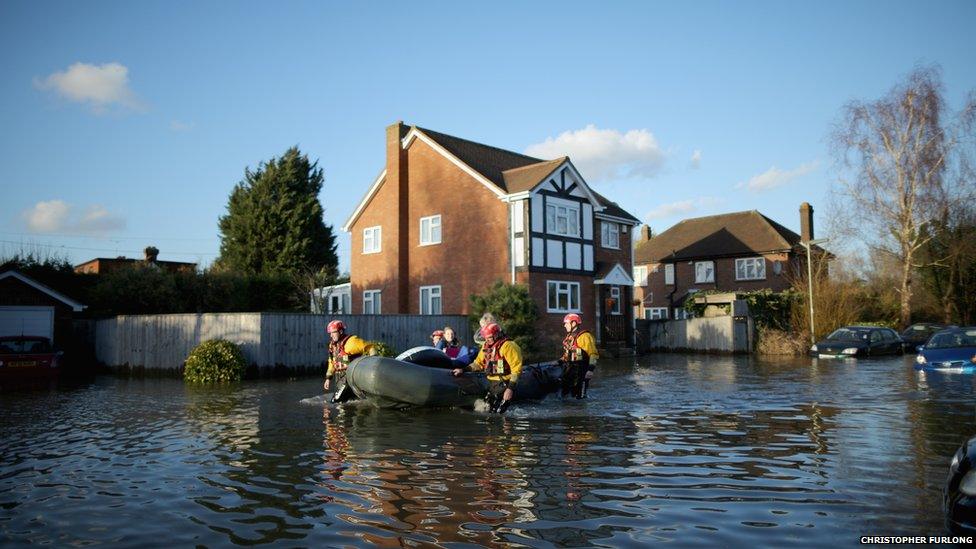
A woman is evacuated from her flooded home by police officers in Chertsey

Tidal surge (5 December)
People living in east Kent are forced to evacuate their homes as a tidal surge threatens the south east.
More than 500 homes in Sandwich, Seasalter, Faversham and the Medway towns are feared at risk and councils in Dover and Canterbury warn residents there is a potential loss of life if they do not leave their homes.
The following day residents return home, to find more than 40 properties in Faversham and Sandwich flooded.
In West Sussex, the A259 through Shoreham is closed, while in East Sussex the Newhaven swing bridge is damaged.
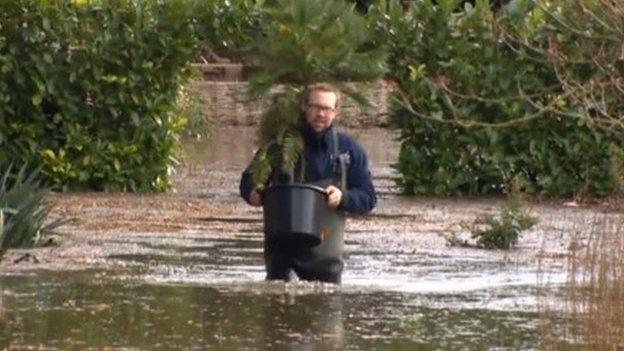
Water was about 1m deep in the gardens of the Grade I listed Salutation House in Sandwich

Festive plans wrecked (23-24 December)
A ferocious storm lashes southern England overnight into Christmas Eve, leaving thousands of people without power and water, and disrupting travel plans.
The River Medway in Kent floods areas from Tonbridge to Allington, with Mereworth and Yalding badly affected.
The coastguard rescues 76 people from a caravan park in Yalding, and more than 600 properties are flooded with the village being one of the worst affected places.
There is also flooding on the Rivers Mole and Wey in Surrey with Dorking, Leatherhead and Guildford placed on flood alerts.
The Fire Brigade calls off a planned strike to help cope with the disruption after it is declared a "major incident".
Flights are cancelled in and out of Gatwick and Southern Electric says 44,000 of its customers are without power.
A key rail route between London and the Sussex coast is disrupted following a landslip at Wadhurst, in East Sussex, while a line is blocked near Ockley, in Surrey, after about a thousand tonnes of embankment collapses from under the tracks.
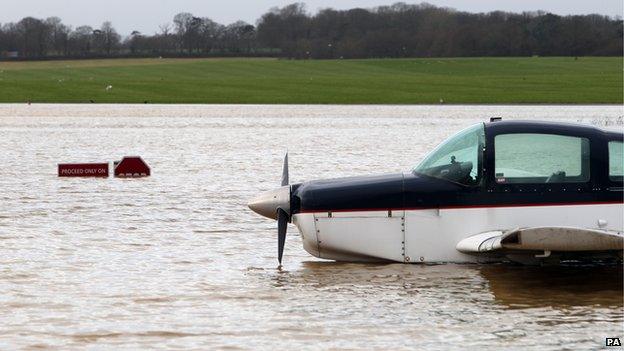
A plane sits in flood water at Redhill aerodrome after heavy rain

Christmas Day ruined (25 December)
For many people in the South East, Christmas Day is spent without power.
UK Power Networks, which supplies about eight million customers in the region, says about 24,000 properties are affected.
Thousands of passengers have their travel plans ruined when they are stranded at Gatwick Airport. The airport says flooded electricity sub-stations led to the problems.
.jpg)
Passengers at Gatwick Airport report that armed police are manning information desks
Cameron confronted (26-27 December)
Families are rescued from their homes and roads are closed as water levels in parts of Kent continue to rise.
Maidstone town centre and the village of Yalding are badly affected by flood water.
In Tonbridge, volunteers meet to help clean up the damage done, while Prime Minister David Cameron visits Yalding, where he is confronted by resident Ericka Olivares who tells him that her local council has done nothing to help villagers

Volunteers meet in the centre of Tonbridge to help clean up the damage caused by flood water
Aerial footage shows the extent of the flooding in Kent, following recent storms

New year, new floods (2-4 January)
Further rainfall brings more flooding to an area of Kent already severely affected by floods over Christmas.
The Little Venice Country Park in Yalding floods overnight when the River Beult overflows, forcing residents to rescue their possessions from mobile homes and move out.
The Environment Agency issues flood warnings and alerts for the South East.
High tides, large waves, and coastal flooding with winds of up to 70mph are predicted for the Sussex coastline over the next 24 hours.
More than 9ft (3m) of the cliff at Birling Gap - part of the Seven Sisters chalk cliffs - subsequently falls into the sea. The cliffs usually erode at a rate of about 2ft (0.7m) a year.
A spokesman says the cliff edges are precarious and there are concerns they could attract fossil hunters.
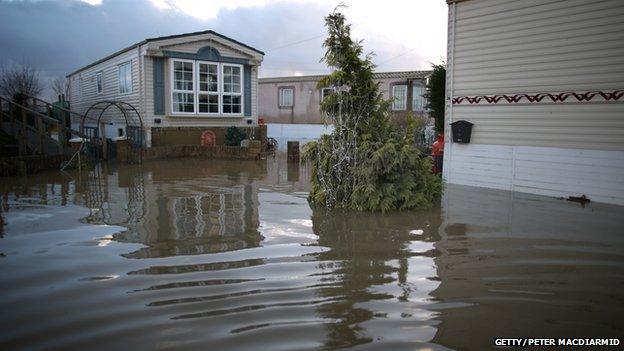
The Little Venice Country Park in Yalding appears to resemble its namesake after the floods hit

The cliff fall at Birling Gap is close to the steps which lead down to the shingle beach

Water sports fun (7-9 January)
Flood defences finished less than three weeks ago at Pagham in West Sussex are damaged in heavy storms.
Temporary flood defences are installed at one end of the High Street in Guildford, as the Environment Agency issues flood warnings for the Rivers Wey, Bourne, Thames and Mole in Surrey.
Flooding affects Guildford, Horley, East and West Molesey, Staines, Sunbury, Thames Ditton, Weybridge, and Chertsey.

A Thames Ditton schoolboy uses a canoe to get to school
In Surrey, some water sports fans decided to try wakeboarding on a road, which looked more like a river

More flood woes (17 January)
It is the turn of residents in west Kent to suffer the effects of the wet weather, as water is pumped out of properties in Brasted, Sundridge, and Westerham after the River Darent bursts its banks.
Sundridge High Street has been turned into a tributary of the River Darent

Flying cats (25 January)
Eyewitnesses report a "mini-tornado" in Chobham, Surrey, that is so powerful it lifts feral cats into the air like "paper bags".
Trees are brought down and property damaged in a storm that also sweeps through Kent and Sussex.
About 13,000 customers are left without power, with one person describing the freak weather as "like something out of a Steven Spielberg film".

The storm brings down trees across several counties in the south east of England

End of the pier (5 February)
Part of Brighton's ruined West Pier collapses after being battered by winds of up to 70mph and rough seas.
A number of its main supports on the eastern side appear to have been washed away, splitting the former pavilion into two sections.
Further along the coast, Newhaven lighthouse is battered by waves during the stormy weather.
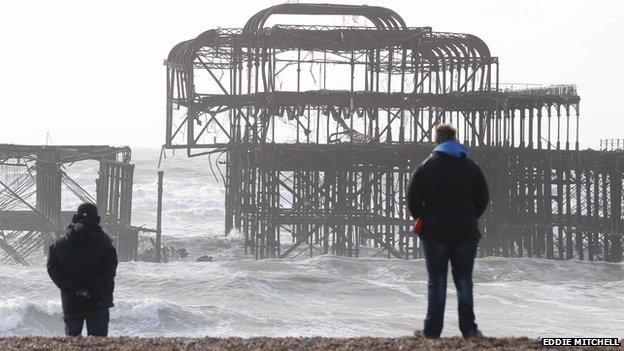
The West Pier's skeletal structure is battered by strong winds and rough seas, splitting it in two
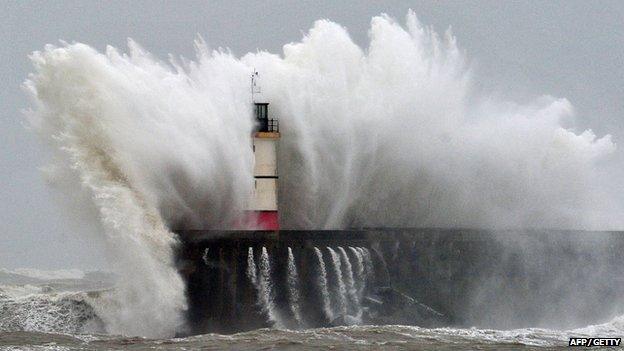
Newhaven lighthouse is battered by waves during stormy weather

Thames alert (7-9 February)
In Surrey, the River Thames bursts its banks at Chertsey, with homeowners warned to expect flooding.
More than 30 flood warnings are issued for Kent, Surrey and Sussex.
Homes are flooded in several parts of east Kent, while a section of the chalk cliffs at Dumpton Gap in Broadstairs collapses onto the beach.

Water from the River Nailbourne floods a number of homes including this house in Patrixbourne

Unprecedented flooding (10-13 February)
Flooding along the River Thames in Surrey forces hundreds of families to leave their homes, with those still there describing their feelings of helpless desperation.
Fire crews, who have been rescuing people from their homes in Staines-upon-Thames, say they have never known waters so deep or a flood rescue operation on this scale.
Surrey Police says about 1,000 homes are flooded after the River Thames reaches its highest level in 60 years.
Chief Constable Lynne Owens says the force's response will continue over the coming weeks, and the situation has the potential to get even worse over the weekend.
Some Southeastern and Southern trains are still affected by landslips from previous storms. There have been 40 across Kent and East Sussex since December, with 10 on the Hastings to Tonbridge line.
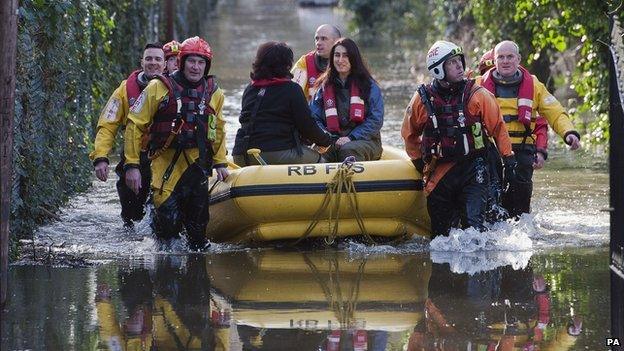
Stranded residents in Staines-upon-Thames are rescued by fire crews
Residents in Chertsey anticipate "serious, serious problems"

Valentine's Day storm (14 February)
The South East prepares for another bout of heavy rain and strong winds with the Met Office warning of gale-force winds of up to 70mph and potential damage to property.
More flood barriers are set up across Surrey, with the Army helping the Environment Agency construct a water-filled dam in Chertsey to protect 200 homes. The sausage-shaped plastic tube angers some residents because it only covers one half of Bridge Road.
Surrey County Council says 20,000 sandbags have been distributed and the most vulnerable residents are being prioritised.
By the afternoon flooding causes problems on a number of roads across the region, and Southeastern says speed restrictions will be in place on some parts of the rail network.
Commuters are also told the railway line between Battle and Robertsbridge in East Sussex will be closed until March as work to repair damage caused in a landslip at Stonegate continues.
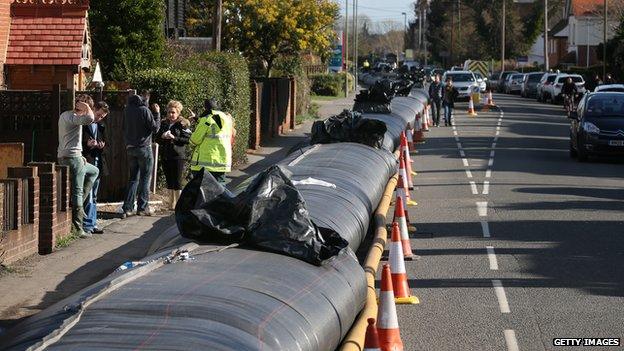
A water-filled flood barrier is erected on Bridge Lane near the River Thames in Chertsey

Storm clear-up (15 February)
Thousands of homes across Kent, Sussex and Surrey are left without power and train services are suspended after the Valentine's Day storm swept across the region overnight, felling trees and flooding roads.
Severe flood warnings remain in place on the River Thames, while the Port of Dover, the QE2 Bridge at the Dartford Crossing and the A249 Sheppey Crossing are all shut until late afternoon.
Beach huts on Hove seafront are destroyed and sea water floods into the Sea Life Centre in Brighton and the arches by Brighton Pier, known as the Artist's Quarter.
Prime Minister David Cameron visits Chertsey before chairing the government's Cobra emergency committee.

Prime Minister David Cameron meets soldiers from the 2nd battalion Royal Gurkha Rifles in Chertsey

'Flood tourists' (17 February)
Thousands of rail passengers travelling between Brighton and London face major disruption after signalling equipment floods at Patcham, near Preston Park.
In Surrey, sightseers are urged not to visit flood-hit areas after residents complain some have been driving through water at speed causing bow waves to wash into their properties.
Hundreds of homes along the River Thames remain flooded.
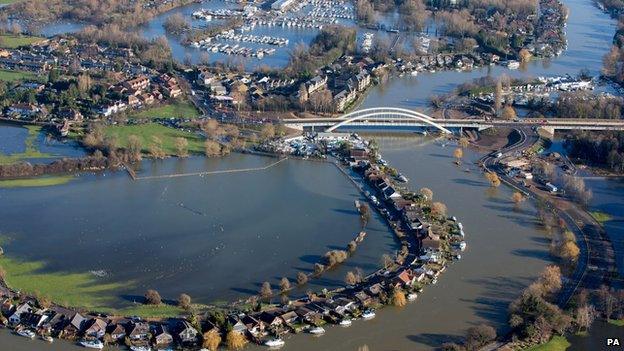
Aerial view of flood water at Walton-on-Thames, in Surrey